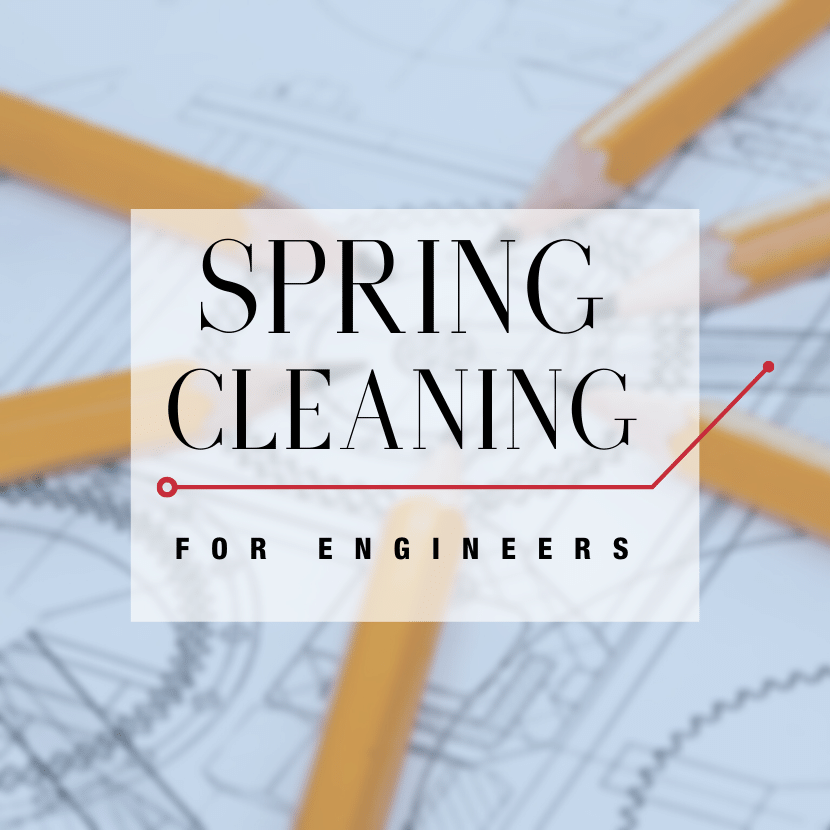
Spring has Sprung, and that only means one thing – It is time for spring cleaning.
As I begin to plan how to tackle the spring cleaning of my home, I think of how we can all do a little spring cleaning at work too. Spring cleaning is a great time to tackle those messes that have gotten out of control. We take control of an unorganized part of our life with the goal of keeping it under control before next spring rolls around. This blog will discuss the spring cleaning of technical drawings, specifically process flow diagrams and equipment layouts/plot plans (but these tips can be used for any type of drawing). Even if we have been diligent about updating drawings as we make changes to our system, there are improvements we can make in the way the information is presented. My goal today is to provide the readers with a few tips on getting their drawings out from the bottom of the clutter pile in the back of the closet and freshen them up and make them useful and usable again.
Before You Begin Spring Cleaning
Before you start cleaning, you should make a list. My ever-growing list to clean up my drawings includes a list of the required information needed, a checklist of common errors in drafting that I try to fix when I review drawings and points of interest that seem to be hot topics to regulatory agencies. The required information will be different for each type of drawing you review. For instance, Piping and Instrumentation Drawings (P&IDs) should list all design pressures and temperatures, capacities, sizes, and so on. A list of items generally on P&IDs can be found here. Or, electrical area classification drawings should have scale locations of all equipment, along with hazardous chemical locations identified. A useful reference for how to create an electrical area class can be found here. Gathering what info you need before you begin spring cleaning your drawings will make the process more successful. The list should include those pesky things on your drawings that have been bugging you every time you look at them but have not had time to tackle. Lastly, I keep a running list of items identified as gaps by regulatory agencies or audits. This info helps keep my drawings from being cited for the same thing twice. OSHA Process Safety Management (PSM) and EPA Risk Management Plan (RMP) list requirements for Process Safety Information (PSI) for hazardous chemicals. The Bureau of Safety and Environment Enforcement (BSEE) also has a list of expectations regarding drawings offshore production platforms (refer to 30.CFR.250 Subpart H found here). Even if you do not fall under their jurisdiction, you can use their requirements as a go-by.
Beginning Spring Cleaning
Remember that this exercise is not to wipe down the countertop you clean every time you cook, but to go deeper into every nook and cranny like under the microwave and behind the coffee maker. You should look deeper at the information provided and make sure that it is correct and complete. A few details that I check each time I review a set of drawings include:
• Checking page continuations for correct page number, pipe size, pressure rating, and description
• Complete equipment details at the top of each page
• Pressure relief valve set points
• Matching equipment or instrument tags to operating procedures or field tags
I bet you can even find a set of redlines in the operator’s desk that need to be corrected on the drawings.
Consider making minor repairs as you spring clean. I am referring to the squeaky door, or loose plug, or broken handle that you have let slide for the past few months. On drawings, these include all those little tasks that are easy to ignore, but eventually clutter drawings and make them unusable. As the equipment is removed from a drawing, it is easy to delete it and cloud the change. No care is given to what the next revision will look like when the clouds are removed with an empty space with long lines going nowhere. Now is an excellent time to:
• Shorten dead-end lines
• Remove lines that no longer have a reason to cross a page
• Adjust how equipment is laid out on a page with large blank spaces
• Fix lines that cross, stair-step or loop around needlessly
• Remove “future” equipment that is not planned for installation
Spring Cleaning is a commitment. Once you take the time to get the work done, the only regret you will have is that you did not get it done sooner. Don’t rush the process. Instead, be methodical, meticulous, and consistent. Follow through with the drafting of any corrections you find. Once you get the eye for details, it is much easier to build good drawing habits to continue using all year long. If you feel that the task is too daunting or don’t know where to start, enlist the help of others (i.e., a fresh set of eyes). If you still can’t get it done, bring in a professional (like myself and my team at Adley Services).
By Susan Frizzell

